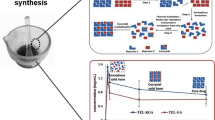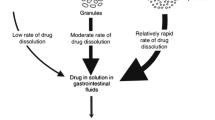Abstract
Purpose
Aceclofenac is a nonsteroidal anti-inflammatory drug (NSAID) belonging to BCS Class II, has a constraint over its therapeutic benefits owing to its poor aqueous solubility.
Methods
In this study, co-amorphous mixtures of Aceclofenac (ACE) with Aspartame (ASPA) of various molar ratios at specific milling times were produced through ball milling (BM) technique. The characterization was done using FTIR, DSC and PXRD. The pellets formulation was prepared by extrusion spheronization method using 32 full factorial design. The optimized formulation was evaluated for in-vitro and in-vivo performance.
Results
Amongst the co amorphous mixtures and pure ACE studied for solubility, ACE: ASPA (1:1) showed the significant increase in solubility and was further formulated as pellets. Solid-state characterization of mixture revealed amorphization of ACE after 120 min of ball milling. In-vitro dissolution study data of F4 pellets formulation revealed (99.00 ± 3.59%) significant increase (P < 0.005) compared to pure drug (50.12 ± 2.52%) and other formulations. The in-vivo studies reveal a significant increase in percent inhibition of inflammation (61.7%) of the prepared formulation (p < 0.05) as compared to the marketed formulation (53.19%), and pure drug (46.8%).
Conclusion
Therefore, the prepared pellets of co-amorphous mixture of aceclofenac and aspartame, boost the solubility and stability of aceclofenac which has a potential to be a promising approach in the management of pain.
Graphical Abstract










Similar content being viewed by others
Data Availability
All the data supporting the findings of this work are incorporated in the article.
References
Wu W, Löbmann K, Schnitzkewitz J, Knuhtsen A, Pedersen DS, Rades T, et al. Dipeptides as co-formers in co-amorphous systems. Eur J Pharm Biopharm. 2019;134:68–76.
Yamazaki R, Kawai S, Matsuzaki T, Kaneda N, Hashimoto S, Yokokura T, et al. Aceclofenac blocks prostaglandin E2 production following its intracellular conversion into cyclooxygenase inhibitors. Eur J Pharmacol. 1997;329:181–7.
Lee J, Lee Y, Kim J, Yoon M, Choi YW. Formulation of microemulsion systems for transdermal delivery of aceclofenac. Arch Pharm Res. 2005;28(9):1097–102
Singh P, Roberts MS. Skin permeability and local tissue concentrations of nonsteroidal anti- inflammatory drugs after topical application. J Pharmacol Exp Ther. 1994;268:144–51.
Cevc G, Blume G. New, highly efficient formulation of diclofenac for the topical, transdermal administration in ultradeformable drug carriers. Transfersomes Biochim Biophys Acta - Biomembr. 2001;1514:191–205.
Yong CS, Oh YK, Kyung HL, Park SM, Park YJ, Young SG, et al. Trials of clear aceclofenac-loaded soft capsules with accelerated oral absorption in human subjects. Int J Pharm. 2005;302:78–83.
Joshi VY, Sawant MR. Study on dissolution rate enhancement of poorly water soluble drug: Contributions of solubility enhancement and relatively low micelle diffusivity. J Dispers Sci Technol. 2006;27:1141–50.
Mutalik S, Anju P, Manoj K, Usha AN. Enhancement of dissolution rate and bioavailability of aceclofenac: A chitosan-based solvent change approach. Int J Pharm. 2008;350:279–90.
Yesmin F, Talukder MMU, Islam MS, Laila S, Haque T. Evaluation of Aceclofenac Loaded Agarose Beads Prepared by Ionotropic Gelation Method. Stamford J Pharm Sci. 1970;1:10–7.
Setty C, Prasad DVK, Gupta VRM, Sa B. Development of fast dispersible aceclofenac tablets: Effect of functionality of superdisintegrants. Indian J Pharm Sci. 2008;70:180–5.
Su M, Xia Y, Shen Y, Heng W, Wei Y, Zhang L, et al. A novel drug-drug coamorphous system without molecular interactions: Improve the physicochemical properties of tadalafil and repaglinide. RSC Adv. 2019;10:565–83.
Yarlagadda DL, Sai Krishna Anand V, Nair AR, Navya Sree KS, Dengale SJ, Bhat K. Considerations for the selection of co-formers in the preparation of co-amorphous formulations. Int J Pharm. 2021;602:120649.
Dengale SJ, Grohganz H, Rades T, Löbmann K. Recent advances in co-amorphous drug formulations. Adv Drug Deliv Rev. 2016;100:116–25. https://doi.org/10.1016/j.addr.2015.12.009.
Jensen KT, Löbmann K, Rades T, Grohganz H. Improving co-amorphous drug formulations by the addition of the highly water soluble amino acid. Proline Pharmaceutics. 2014;6:416–35.
Löbmann K, Laitinen R, Grohganz H, Gordon KC, Strachan C, Rades T. Coamorphous drug systems: Enhanced physical stability and dissolution rate of indomethacin and naproxen. Mol Pharm. 2011;8:1919–28.
Löbmann K, Strachan C, Grohganz H, Rades T, Korhonen O, Laitinen R. Co-amorphous simvastatin and glipizide combinations show improved physical stability without evidence of intermolecular interactions. Eur J Pharm Biopharm. 2012;81:159–69.
Qian S, Heng W, Wei Y, Zhang J, Gao Y. Coamorphous lurasidone hydrochloride-saccharin with charge-assisted hydrogen bonding interaction shows improved physical stability and enhanced dissolution with ph-independent solubility behavior. Cryst Growth Des. 2015;15:2920–8.
Hatwar P, Pathan IB, Chishti NAH, Ambekar W. Pellets containing quercetin amino acid co-amorphous mixture for the treatment of pain: Formulation, optimization, in-vitro and in-vivo study. J Drug Deliv Sci Technol. 2021;62:102350.
Liu J, Grohganz H, Löbmann K, Rades T, Hempel NJ. Co-amorphous drug formulations in numbers: Recent advances in co-amorphous drug formulations with focus on co-formability, molar ratio, preparation methods, physical stability, in vitro and in vivo performance, and new formulation strategies. Pharmaceutics. 2021;13:389.
Wu W, Löbmann K, Schnitzkewitz J, Knuhtsen A, Pedersen DS, Grohganz H, et al. Aspartame as a co-former in co-amorphous systems. Int J Pharm. 2018;549:380–7.
Kasten G, Grohganz H, Rades T, Löbmann K. Development of a screening method for co-amorphous formulations of drugs and amino acids. Eur J Pharm Sci. 2016;95:28–35.
American Cancer Society. Aspartame and cancer risk. Am Cancer Soc. 2023;1–7. Cancer.org.
Ghebre SI. Pellets: a general overview. In Ghebre-Sellassie (eds.), Pharmaceutical Pelletization Technology, Marcel Dekker Inc. New York, 1989, 1–13.
Issa MG, Ferraz HG. Intrinsic dissolution as a tool for evaluating drug solubility in accordance with the biopharmaceutics classification system. Dissolution Technol. 2011;18:6–13.
Madgulkar AR, Bhalekar MR, Padalkar RR. Formulation design and optimization of novel taste masked mouth-dissolving tablets of tramadol having adequate mechanical strength. AAPS PharmSciTech. 2009;10:574–81.
Gowda DV, Rajesh N, Moin A, Shivakumar HG, Siddaramaiah. Controlled release behaviour of nifedipine from the pellets of gelucire/microcrystalline cellulose blends. Int J PharmTech Res. 2010;2:1215–26.
Singh R, Poddar SS, Chivate A. Sintering of wax for controlling release from pellets. AAPS PharmSciTech. 2007;8:E175–83.
Mahdi HJ. Eudragit L-100 for enteric coating of hard gelatine capsules: Formulation and evaluation. Issues Biol Sci Pharm Res. 2015;3:14–20. https://doi.org/10.15739/ibspr.008.
Sadeghi H, Hajhashemi V, Minaiyan M, Movahedian A, Talebi A. A study on the mechanisms involving the anti-inflammatory effect of amitriptyline in carrageenan-induced paw edema in rats. Eur J Pharmacol. 2011;667:396–401.
Winter CA, Risley EA, Nuss GW. Carrageenin-Induced Edema in Hind Paw of the Rat as an Assay for Antiinflammatory Drugs. Proc Soc Exp Biol Med. 1962;111:544–7.
Pathan IB, Jaware BP, Shelke S, Ambekar W. Curcumin loaded ethosomes for transdermal application: Formulation, optimization, in-vitro and in-vivo study. J Drug Deliv Sci Technol. 2018;44:49–57.
European Medicines Agency. ICH Topic Q 1 A (R2). Stability testing of new drug substances and products. CPMP/ICH/2736/99.
Pathan IB, Munde SJ, Shelke S, Ambekar W, Mallikarjuna SC. Curcumin loaded fish scale collagen-HPMC nanogel for wound healing application: Ex-vivo and In-vivo evaluation. Int J Polym Mater Polym Biomater. 2019;68:165–74.
Chavan RB, Thipparaboina R, Kumar D, Shastri NR. Co amorphous systems: A product development perspective. Int J Pharm. 2016;515(1):403–15.
Allesø M, Chieng N, Rehder S, Rantanen J, Rades T, Aaltonen J. Enhanced dissolution rate and synchronized release of drugs in binary systems through formulation: Amorphous naproxen-cimetidine mixtures prepared by mechanical activation. J Control Release. 2009;136:45–53.
Lenz E, Jensen KT, Blaabjerg LI, Knop K, Grohganz H, Löbmann K, et al. Solid-state properties and dissolution behaviour of tablets containing co-amorphous indomethacin-arginine. Eur J Pharm Biopharm. 2015;96:44–52.
Zhu S, Gao H, Babu S, Garad S. Co-amorphous formation of high-dose zwitterionic compounds with amino acids to improve solubility and enable parenteral delivery. Mol Pharm. 2018;15:97–107.
Bisrat M, Nyström C. Physicochemical aspects of drug release. VIII. The relation between particle size and surface specific dissolution rate in agitated suspensions. Int J Pharm. 1988;47:223–31.
Rahim H, Sadiq A, Ullah R, Bari A, Amin F, Farooq U, et al. Formulation of aceclofenac tablets using nanosuspension as granulating agent: An attempt to enhance dissolution rate and oral bioavailability. Int J Nanomedicine. 2020;15:8999–9009.
Heinz A, Strachan CJ, Gordon KC, Rades T. Analysis of solid-state transformations of pharmaceutical compounds using vibrational spectroscopy. J Pharm Pharmacol. 2009;61:971–88.
Mutalik S, Naha A, Usha AN, Ranjith AK, Musmade P, Manoj K, et al. Preparation, in vitro, preclinical and clinical evaluations of once daily sustained release tablets of aceclofenac. Arch Pharm Res. 2007;30:222–34.
Ueda H, Muranushi N, Sakuma S, Ida Y, Endoh T, Kadota K, et al. A Strategy for Co-former Selection to Design Stable Co-amorphous Formations Based on Physicochemical Properties of Non-steroidal Inflammatory Drugs. Pharm Res. 2016;33:1018–29.
Hsieh W, Cheng W, Chen L, Lin S. Non-isothermal dehydration kinetic study of aspartame hemihydrate using DSC, TGA and DSC-FTIR microspectroscopy. Asian J Pharm Sci. 2018;13:212–9.
El-Shattawy HH, Kildsig DO, Peck GE. Differential scanning calorimetry of aspartame-caffeine mixture. Drug Dev Ind Pharm. 1982;8:651–62.
Essa EA, Balata GF. Preparation and characterization of domperidone solid dispersions. Pak J Pharm Sci. 2012;25:783–91.
Einfal T, Planinšek O, Hrovat K. Methods of amorphization and investigation of the amorphous state. Acta Pharm. 2013;63:305–34.
Johari GP, Ram S, Astl G, Mayer E. Characterizing amorphous and microcrystalline solids by calorimetry. J Non Cryst Solids. 1990;116:282–5.
Fatimah S, Ragadhita R, Fitria D, Husaeni A, Bayu A, Nandiyanto D. ASEAN Journal of Science and Engineering How to Calculate Crystallite Size from X-Ray Diffraction ( XRD ) using Scherrer Method. J Sci Eng. 2022;2:65–76.
Dengale SJ, Ranjan OP, Hussen SS, Krishna BSM, Musmade PB, Gautham Shenoy G, et al. Preparation and characterization of co-amorphous Ritonavir-Indomethacin systems by solvent evaporation technique: Improved dissolution behavior and physical stability without evidence of intermolecular interactions. Eur J Pharm Sci. 2014;62:57–64.
Kimaro E, Tibalinda P, Shedafa R, Temu M, Kaale E. Formulation development of chewable albendazole tablets with improved dissolution rate. Heliyon. 2019;5:e02911.
Yohana Chaerunisaa A, Sriwidodo S, Abdassah M. Microcrystalline cellulose as pharmaceutical excipient. Pharm Formul Des - Recent Pract. IntechOpen. 2020.
Hausner HH. Friction Conditions in a Mass of Metal Powder. Int J Powder Metall. 1967;3:7–13.
Vasconcelos T, Sarmento B, Costa P. Solid dispersions as strategy to improve oral bioavailability of poor water soluble drugs. Drug Discov Today. 2007;12(23–24)1068–75.
Kilor VA, Sapkal NP, Awari JG, Shewale BD. Development and characterization of enteric-coated immediate-release pellets of aceclofenac by extrusion/spheronization technique using κ-carrageenan as a pelletizing agent. AAPS PharmSciTech. 2010;11:336–43.
Mahajan AK, Singh H, Tung BS. Effect of concurrent use of cimetidine and antiinflammatory agents in experimental models of peptic ulcer and inflammation. Indian J Pharmacol. 1984;16:132–5.
Arora P, Mukherjee B. Design, development, physicochemical, and in vitro and in vivo evaluation of transdermal patches containing diclofenac diethylammonium salt. J Pharm Sci. 2002;91:2076–89.
Ibrahim MA, El-badry M. Formulation of immediate release pellets containing famotidine solid dispersions. Saudi Pharm J. 2014;22:149–56.
Law MFL, Deasy PB. Use of canonical and other analyses for the optimization of an extrusion-spheronization process for indomethacin. Int J Pharm. 1997;146:1–9.
Acknowledgements
The authors thank Wockhardt Ltd., India for providing the gift sample of Aceclofenac. The authors are grateful to research centre, Y. B. Chavan College of Pharmacy Dr. Rafiq Zakaria Campus Aurangabad, Maharashtra, India for providing facilities to carry out this research work.
Funding
This research did not receive any specific grant from funding agencies in the public, commercial, or not-for-profit sectors.
Author information
Authors and Affiliations
Corresponding author
Ethics declarations
The institution and national guidelines for the care and use of laboratory animals were followed.
Conflict of Interest
The authors report no conflicts of interest.
Additional information
Publisher's Note
Springer Nature remains neutral with regard to jurisdictional claims in published maps and institutional affiliations.
Rights and permissions
Springer Nature or its licensor (e.g. a society or other partner) holds exclusive rights to this article under a publishing agreement with the author(s) or other rightsholder(s); author self-archiving of the accepted manuscript version of this article is solely governed by the terms of such publishing agreement and applicable law.
About this article
Cite this article
Chishti, N.A.H., Pathan, I.B., Dehghan, M.H.G. et al. Design and Development of Immediate Release Pellets Formulation Containing Co Amorphous Mixture of Aceclofenac: In-Vitro and In-Vivo Study. J Pharm Innov 19, 13 (2024). https://doi.org/10.1007/s12247-024-09823-z
Accepted:
Published:
DOI: https://doi.org/10.1007/s12247-024-09823-z




